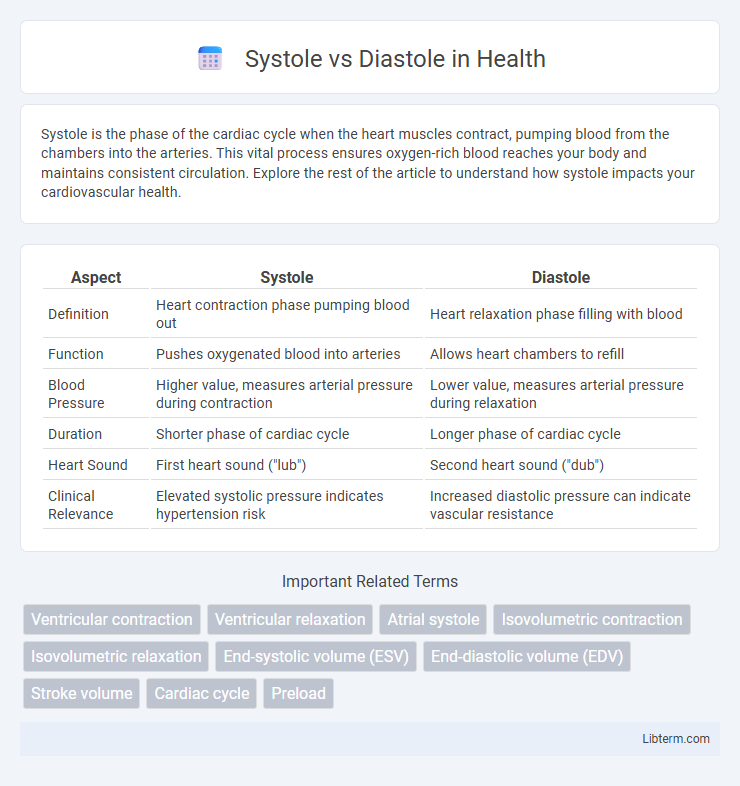Systole is the phase of the cardiac cycle when the heart muscles contract, pumping blood from the chambers into the arteries. This vital process ensures oxygen-rich blood reaches your body and maintains consistent circulation. Explore the rest of the article to understand how systole impacts your cardiovascular health.
Table of Comparison
| Aspect | Systole | Diastole |
|---|---|---|
| Definition | Heart contraction phase pumping blood out | Heart relaxation phase filling with blood |
| Function | Pushes oxygenated blood into arteries | Allows heart chambers to refill |
| Blood Pressure | Higher value, measures arterial pressure during contraction | Lower value, measures arterial pressure during relaxation |
| Duration | Shorter phase of cardiac cycle | Longer phase of cardiac cycle |
| Heart Sound | First heart sound ("lub") | Second heart sound ("dub") |
| Clinical Relevance | Elevated systolic pressure indicates hypertension risk | Increased diastolic pressure can indicate vascular resistance |
Introduction to Systole and Diastole
Systole and diastole are the two primary phases of the cardiac cycle responsible for maintaining effective blood circulation. Systole involves the contraction of the heart muscles, primarily the ventricles, to pump blood into the arteries. Diastole follows with the relaxation of the heart chambers, allowing them to fill with blood in preparation for the next heartbeat.
Understanding the Cardiac Cycle
Systole and diastole are essential phases of the cardiac cycle, where systole refers to the contraction of the heart muscles, pumping blood into the arteries, and diastole is the relaxation phase allowing the chambers to fill with blood. The coordinated timing between systole and diastole ensures efficient blood circulation, maintaining optimal cardiac output and blood pressure. Understanding these phases provides crucial insights into heart function, diagnosis of cardiac disorders, and the development of treatments for cardiovascular diseases.
What Happens During Systole?
During systole, the heart's ventricles contract, forcing blood out of the heart and into the arteries. This phase increases arterial pressure, known as systolic blood pressure, as oxygenated blood is pumped into the aorta and pulmonary artery. The mitral and tricuspid valves close to prevent backflow, while the aortic and pulmonary valves open to allow blood ejection.
Key Processes of Diastole
During diastole, the heart muscles relax, allowing the ventricles to fill with blood from the atria, which is critical for maintaining efficient cardiac output. The relaxation phase lowers intraventricular pressure, facilitating the opening of the atrioventricular valves (mitral and tricuspid) to ensure smooth ventricular filling. This process replenishes blood volume in the ventricles, preparing the heart for the subsequent systolic contraction that pumps blood into the systemic and pulmonary circulation.
Differences Between Systole and Diastole
Systole refers to the phase of the cardiac cycle when the heart muscles contract, pumping blood out of the chambers into the arteries, resulting in increased blood pressure. Diastole is the phase when the heart muscles relax, allowing the chambers to fill with blood, causing a decrease in blood pressure. The primary difference between systole and diastole lies in their functions: systole is the contraction phase generating blood ejection, while diastole is the relaxation phase facilitating heart chamber filling.
Importance in Blood Pressure Measurement
Systole represents the pressure in arteries when the heart contracts and pumps blood, indicating the maximum force exerted on arterial walls. Diastole measures the pressure during heart relaxation between beats, reflecting the minimum arterial pressure and vascular resistance. Accurate assessment of both systolic and diastolic values is crucial for diagnosing hypertension and managing cardiovascular risk.
Systolic vs Diastolic Dysfunction
Systolic dysfunction occurs when the heart's left ventricle loses its ability to contract effectively, leading to reduced ejection fraction and impaired blood pumping. Diastolic dysfunction involves the heart's inability to relax and fill properly during diastole, causing increased ventricular stiffness and elevated filling pressures despite normal ejection fraction. Both conditions contribute to heart failure but require distinct diagnostic approaches and targeted treatments based on whether systolic or diastolic impairment predominates.
Factors Affecting Systole and Diastole
Systole and diastole are phases of the cardiac cycle influenced by factors such as heart rate, preload, afterload, and contractility. Increased preload enhances systolic volume by stretching cardiac muscle fibers, while elevated afterload can reduce ejection efficiency during systole. Diastolic function depends on ventricular relaxation and compliance, which can be impaired by hypertension or myocardial stiffness, impacting ventricular filling and overall cardiac output.
Clinical Significance in Heart Health
Systole and diastole represent the phases of the cardiac cycle crucial for maintaining effective blood circulation and heart health. Systole refers to the contraction phase where the heart pumps oxygenated blood into the arteries, directly impacting systolic blood pressure readings used to assess cardiovascular risk. Diastole involves the relaxation phase allowing heart chambers to fill with blood, influencing diastolic blood pressure and helping clinicians evaluate conditions such as hypertension and heart failure.
Tips for Maintaining Healthy Cardiac Cycles
Maintaining a healthy balance between systole and diastole is crucial for optimal heart function, emphasizing the importance of regular cardiovascular exercise to improve heart muscle strength and promote efficient blood flow during systolic contraction. Managing blood pressure through a low-sodium diet and stress reduction techniques supports healthy diastolic relaxation, allowing the heart chambers to fill properly. Consistent monitoring of heart rate variability and avoiding smoking can further enhance the rhythmic coordination of cardiac cycles, reducing the risk of heart disease.
Systole Infographic

 libterm.com
libterm.com